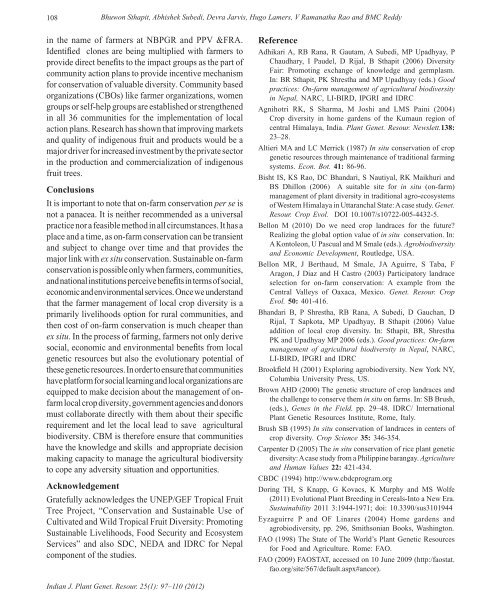indian society of plant genetic resources - Bioversity International
indian society of plant genetic resources - Bioversity International
indian society of plant genetic resources - Bioversity International
Create successful ePaper yourself
Turn your PDF publications into a flip-book with our unique Google optimized e-Paper software.
108<br />
Bhuwon Sthapit, Abhishek Subedi, Devra Jarvis, Hugo Lamers, V Ramanatha Rao and BMC Reddy<br />
in the name <strong>of</strong> farmers at NBPGR and PPV &FRA.<br />
Identifi ed clones are being multiplied with farmers to<br />
provide direct benefi ts to the impact groups as the part <strong>of</strong><br />
community action plans to provide incentive mechanism<br />
for conservation <strong>of</strong> valuable diversity. Community based<br />
organizations (CBOs) like farmer organizations, women<br />
groups or self-help groups are established or strengthened<br />
in all 36 communities for the implementation <strong>of</strong> local<br />
action plans. Research has shown that improving markets<br />
and quality <strong>of</strong> indigenous fruit and products would be a<br />
major driver for increased investment by the private sector<br />
in the production and commercialization <strong>of</strong> indigenous<br />
fruit trees.<br />
Conclusions<br />
It is important to note that on-farm conservation per se is<br />
not a panacea. It is neither recommended as a universal<br />
practice nor a feasible method in all circumstances. It has a<br />
place and a time, as on-farm conservation can be transient<br />
and subject to change over time and that provides the<br />
major link with ex situ conservation. Sustainable on-farm<br />
conservation is possible only when farmers, communities,<br />
and national institutions perceive benefi ts in terms <strong>of</strong> social,<br />
economic and environmental services. Once we understand<br />
that the farmer management <strong>of</strong> local crop diversity is a<br />
primarily livelihoods option for rural communities, and<br />
then cost <strong>of</strong> on-farm conservation is much cheaper than<br />
ex situ. In the process <strong>of</strong> farming, farmers not only derive<br />
social, economic and environmental benefi ts from local<br />
<strong>genetic</strong> <strong>resources</strong> but also the evolutionary potential <strong>of</strong><br />
these <strong>genetic</strong> <strong>resources</strong>. In order to ensure that communities<br />
have platform for social learning and local organizations are<br />
equipped to make decision about the management <strong>of</strong> onfarm<br />
local crop diversity, government agencies and donors<br />
must collaborate directly with them about their specifi c<br />
requirement and let the local lead to save agricultural<br />
biodiversity. CBM is therefore ensure that communities<br />
have the knowledge and skills and appropriate decision<br />
making capacity to manage the agricultural biodiversity<br />
to cope any adversity situation and opportunities.<br />
Acknowledgement<br />
Gratefully acknowledges the UNEP/GEF Tropical Fruit<br />
Tree Project, “Conservation and Sustainable Use <strong>of</strong><br />
Cultivated and Wild Tropical Fruit Diversity: Promoting<br />
Sustainable Livelihoods, Food Security and Ecosystem<br />
Services” and also SDC, NEDA and IDRC for Nepal<br />
component <strong>of</strong> the studies.<br />
Indian J. Plant Genet. Resour. 25(1): 97–110 (2012)<br />
Reference<br />
Adhikari A, RB Rana, R Gautam, A Subedi, MP Upadhyay, P<br />
Chaudhary, I Paudel, D Rijal, B Sthapit (2006) Diversity<br />
Fair: Promoting exchange <strong>of</strong> knowledge and germplasm.<br />
In: BR Sthapit, PK Shrestha and MP Upadhyay (eds.) Good<br />
practices: On-farm management <strong>of</strong> agricultural biodiversity<br />
in Nepal, NARC, LI-BIRD, IPGRI and IDRC<br />
Agnihotri RK, S Sharma, M Joshi and LMS Paini (2004)<br />
Crop diversity in home gardens <strong>of</strong> the Kumaun region <strong>of</strong><br />
central Himalaya, India. Plant Genet. Resour. Newslett.138:<br />
23–28.<br />
Altieri MA and LC Merrick (1987) In situ conservation <strong>of</strong> crop<br />
<strong>genetic</strong> <strong>resources</strong> through maintenance <strong>of</strong> traditional farming<br />
systems. Econ. Bot. 41: 86-96.<br />
Bisht IS, KS Rao, DC Bhandari, S Nautiyal, RK Maikhuri and<br />
BS Dhillon (2006) A suitable site for in situ (on-farm)<br />
management <strong>of</strong> <strong>plant</strong> diversity in traditional agro-ecosystems<br />
<strong>of</strong> Western Himalaya in Uttaranchal State: A case study. Genet.<br />
Resour. Crop Evol. DOI 10.1007/s10722-005-4432-5.<br />
Bellon M (2010) Do we need crop landraces for the future?<br />
Realizing the global option value <strong>of</strong> in situ conservation. In:<br />
A Kontoleon, U Pascual and M Smale (eds.). Agrobiodiversity<br />
and Economic Development, Routledge, USA.<br />
Bellon MR, J Berthaud, M Smale, JA Aguirre, S Taba, F<br />
Aragon, J Diaz and H Castro (2003) Participatory landrace<br />
selection for on-farm conservation: A example from the<br />
Central Valleys <strong>of</strong> Oaxaca, Mexico. Genet. Resour. Crop<br />
Evol. 50: 401-416.<br />
Bhandari B, P Shrestha, RB Rana, A Subedi, D Gauchan, D<br />
Rijal, T Sapkota, MP Upadhyay, B Sthapit (2006) Value<br />
addition <strong>of</strong> local crop diversity. In: Sthapit, BR, Shrestha<br />
PK and Upadhyay MP 2006 (eds.). Good practices: On-farm<br />
management <strong>of</strong> agricultural biodiversity in Nepal, NARC,<br />
LI-BIRD, IPGRI and IDRC<br />
Brookfi eld H (2001) Exploring agrobiodiversity. New York NY,<br />
Columbia University Press, US.<br />
Brown AHD (2000) The <strong>genetic</strong> structure <strong>of</strong> crop landraces and<br />
the challenge to conserve them in situ on farms. In: SB Brush,<br />
(eds.), Genes in the Field. pp. 29–48. IDRC/ <strong>International</strong><br />
Plant Genetic Resources Institute, Rome, Italy.<br />
Brush SB (1995) In situ conservation <strong>of</strong> landraces in centers <strong>of</strong><br />
crop diversity. Crop Science 35: 346-354.<br />
Carpenter D (2005) The in situ conservation <strong>of</strong> rice <strong>plant</strong> <strong>genetic</strong><br />
diversity: A case study from a Philippine barangay. Agriculture<br />
and Human Values 22: 421-434.<br />
CBDC (1994) http://www.cbdcprogram.org<br />
Doring TH, S Knapp, G Kovacs, K Murphy and MS Wolfe<br />
(2011) Evolutional Plant Breeding in Cereals-Into a New Era.<br />
Sustainability 2011 3:1944-1971; doi: 10.3390/sus3101944<br />
Eyzaguirre P and OF Linares (2004) Home gardens and<br />
agrobiodiversity, pp. 296, Smithsonian Books, Washington.<br />
FAO (1998) The State <strong>of</strong> The World’s Plant Genetic Resources<br />
for Food and Agriculture. Rome: FAO.<br />
FAO (2009) FAOSTAT, accessed on 10 June 2009 (http:/faostat.<br />
fao.org/site/567/default.aspx#ancor).

















